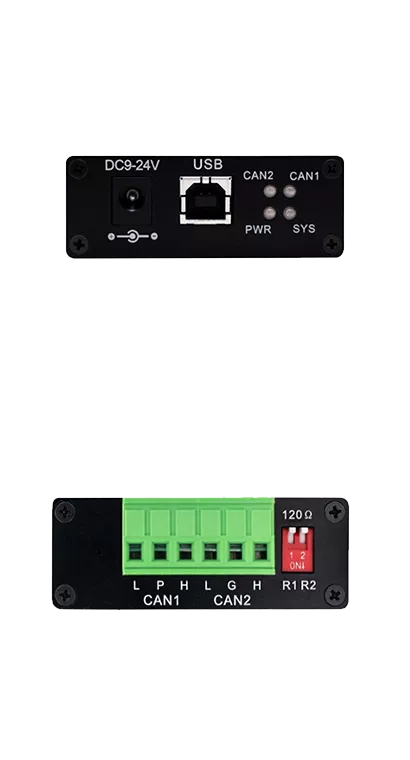When using a CAN box (Controller Area Network Box), users may encounter a series of problems involving hardware connection, software configuration, communication stability, and troubleshooting. The following are some common problems encountered when using a CAN box and their possible solutions:
I. Hardware connection problems
Unstable USB interface connection
Problem description: The connection between the CAN box and the computer is unstable, resulting in interrupted data transmission or inability to communicate.
Solution: Unplug and plug the USB port again, check whether the USB status light is on, and ensure a stable connection. If the problem persists, try to replace the USB interface or USB cable.
CAN interface line problem
Problem description: The CAN interface line is damaged, poor contact, or the connector is faulty.
Solution: Check whether the CAN interface line is intact and the interface is firm. If damaged, replace it in time. At the same time, check whether the connector has good contact. If there is poor contact or corrosion, clean or replace the connector.
Wiring error
Problem description: The RXD and TXD wiring connected to the CAN controller is wrong, or the CAN_H and CAN_L wiring is wrong.
Solution: Make sure that the TXD pin of the CAN box is connected to the TXD output pin of the controller, and the RXD pin is connected to the RXD input pin of the controller. The CAN_H pin needs to be connected to the CAN_H pin of other transceivers, and CAN_L needs to be connected to CAN_L.

II. Software configuration problem
The driver is not installed correctly
Problem description: The driver is not installed correctly or the version does not match, resulting in the device and computer not being able to communicate properly.
Solution: Check whether the driver file corresponds to different interface series and operating systems, and install it according to the correct driver file provided by the manufacturer.
The wrong CAN box model is selected
Problem description: The wrong CAN box model is selected in the software, resulting in the software not being able to correctly identify the device.
Solution: Select the correct CAN box model in the device list.
Incorrect network configuration
Problem description: Incorrect settings of network configuration parameters including baud rate, data bits, stop bits, etc., resulting in communication failure.
Solution: Check and verify the network configuration parameters to ensure that they match other devices in the CAN network.
III. Communication stability problem
Power supply problem
Problem description: Power supply connection problem or unstable power supply voltage causes the CAN box to not work properly.
Solution: Make sure the power connection of the CAN box is normal and the power supply voltage is within the specified range. Use a regulated power supply to reduce voltage fluctuations.
Electromagnetic interference
Problem description: Using the CAN box in an environment with strong magnetic fields or high-frequency signal interference leads to unstable or failed communication.
Solution: Evaluate and optimize the physical environment to reduce potential sources of interference. For example, increase shielding measures, use connecting wires with better anti-interference performance, etc.
No terminal resistor
Problem description: In high-speed CAN communication, communication abnormalities are caused by the lack of terminal resistors.
Solution: Add 120 ohm terminal resistors at both ends of the CAN network to ensure the stability and reliability of communication.
IV. Data reception problem
Incorrect baud rate setting
Problem description: The baud rate setting of the CAN box does not match the baud rate of the CAN bus, resulting in failure to correctly receive data.
Solution: Make sure that the baud rate setting of the CAN box matches the baud rate of the CAN bus.
Incorrect data format setting
Problem description: The data format (such as extended frame and general frame) setting of the CAN box does not match the data sent.
Solution: Check and adjust the data format setting of the CAN box to ensure that it matches the data sent.
CAN bus transceiver failure
Problem description: CAN bus transceiver failure causes inability to receive data.
Solution: Check the working status of the CAN bus transceiver and replace the transceiver if necessary.
If you need a CAN box device, please feel free to contact me info@gcanbus.com/13644001762
